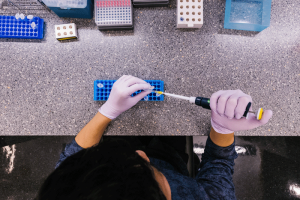Enter your address to receive notifications about new posts to your email.
-
Midnight munchers: starved worms can’t sleep
Food-deprivation inhibits the stress-induced sleep response in C. elegans. For many animals, the essential physiological drives of sleep and food are intimately linked. You might have noticed this if you’ve ever stayed up far too late and found yourself craving a snack. Yet because it’s impossible for most animals to eat and sleep at the…
-
Drosophila development in the drink
A fruit fly model of fetal alcohol spectrum disorder reveals a Cyclin E-centric network modifies developmental sensitivity. Alcohol exposure in utero can lead to a wide range of developmental problems, even causing fetal death in some cases. But since this exposure doesn’t always have the same outcome, is it more likely to be a problem…
-
Chinonye Nnakwe Whitley leaves room for serendipity
NSF Program Officer Chinonye Nnakwe Whitley combines her skills in business, academia and entrepreneurship to empower underrepresented scientists. In addition to her work on the NSF EPSCoR (Established Program to Stimulate Competitive Research) team, she leads innovation training workshops for early career scientists. In the Decoding Life series, we talk to geneticists with diverse career paths, tracing…
-
Looking for teaching ideas? Genetics articles in CourseSource, Fall 2018
Guest post by Michelle Smith, Cornell University. Teaching genetics and looking for some new course ideas? Check out CourseSource, which is a peer-reviewed, open-access journal that publishes articles describing undergraduate biology activities. All the activities are aligned with learning goals written by life science professional societies, including GSA. Here are some recent genetics articles: Meiosis: A…
-
The California Council on Science and Technology Policy Fellowship: an inside view
This post is part of the Early Career Scientist Policy Subcommittee’s series on science policy fellowships. The Science & Technology Policy Fellows Program of the California Council on Science & Technology (CCST) places ten PhD-level scientists in the California legislature for one-year appointments. Fellows work hands-on with policymakers addressing complex scientific and technical issues as…
-
Katherine Xue studies how the flu evolves inside you
The recipient of the 2018 Crow Award reveals details of flu evolution at the smallest —and largest—scales. For many viral diseases, a vaccine can provide lifelong protection. But for flu, you need a new shot every year. The influenza virus evolves so fast it presents a constantly moving target for both our immune systems and…
-
Addressing sexual harassment in STEM
Guest post by members of the Early Career Scientist Policy Subcommittee Emily Lescak, Giovanna Collu, and Lacy Barton Recent high-profile cases of sexual misconduct in science have revealed a pervasive undercurrent of harassment in the STEM workplace. How should scientists, institutions, and funding agencies respond? Given the importance of this issue, we wanted to provide…
-
Navigating the maize of heritable epigenetic change
Tissue culture causes heritable methylation changes in plants. Tissue culture is a useful tool for plant scientists and horticulturalists in large part because it allows them to produce clones. Inconveniently, however, these clones are not always identical to the original, as one might expect them to be. In a report in GENETICS, Han et al.…
-
A new tool for longevity and mating studies in C. elegans
By borrowing a system found in plants, researchers can turn off sperm production in an inducible, reversible, and non-toxic manner Let’s say you want to study how your favorite gene affects aging. You pick Caenorhabditis elegans for your study because it is one of the most important models of aging, and you put some of…
-
Enhancing our view of enhancers
GC content alone is associated with distinct functional classes of human enhancers. Because enhancers can be located hundreds of kilobases away from their target genes, it can be challenging to accurately predict their functions. A new report in GENETICS uses sequence composition to distinguish two enhancer classes that have distinct functions and spatial organization in humans.…










